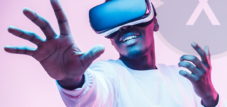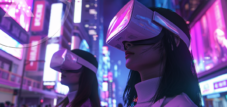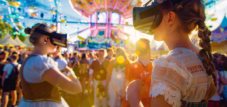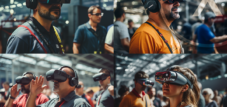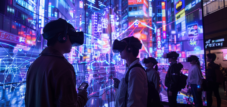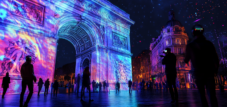Published on: April 21, 2025 / update from: April 21, 2025 - Author: Konrad Wolfenstein

Extended Reality | The discovery of “Olo”: a new color and its potential for virtual reality - picture: xpert.digital
Olo - the color of the future? How a new color could change our world
Unknown color delighted: scientists reveal spectacular innovation
A research team from the University of California, Berkeley, has made a groundbreaking discovery: a completely new color you called "Olo". This color exists outside of our natural spectrum of perception and could have significant effects for the future of virtual reality. A special method for stimulation of certain retinal cells creates a color perception, which is described as "unimaginably saturated" and "breathtaking". Researchers see the potential to increase the intensity of virtual reality experiences and to open up new ways in display technology.
The creation and perception of “Olo”
Our color perception is based on three types of tap cells in the retina: S-cones (short-wave, e.g. blue), M-cones (medium-wave, greenish) and L-cones (long-wave, reddish). These enable us to perceive millions of colors. Normally, the reaction areas of these cones overlap, especially in the M-cones, which means that some theoretical colors for our visual system remain unreachable.
The research team developed a method called “OZ” that deals with this restriction. Instead of producing colors by the mixture of light waves, the OZ system stimulates thousands of M cones with tiny, safe laser pulses. The name “Oz” is an allusion to the emerald city “The Wizard of Oz”, where everything appears in a bright green.
For this precise stimulation, the retina of each user must be mapped in detail. With special cameras, the positions of the individual tap cells are recorded and then followed in real time in order to precisely align the laser rays. This process creates a stimulation pattern that does not occur in the natural environment and leads to a completely new color impression.
The name “Olo” is derived from the coordinates “0.1.0” in the three-dimensional color space-zero stimulation of the L and S cones, full stimulation of the M cones. All participants in the experiment reported an extremely saturated blue -green color, so intense that it could not be compared to known colors. Ren NG, one of the researchers involved, describes the color as "unimaginably saturated" and "breathtaking", which is reminiscent of a bright turquoise.
Suitable for:
The exclusivity of the new color
So far, only five people with normal eyesight have ever seen olo. The perception of this color is extremely exclusive, since a special test setup is required, in which you have to get laser light in a well -fixed eye - a process that is both impractical and potentially uncomfortable.
In order to check the uniqueness of “Olo”, the researchers carried out color accumulation tests. “Olo” was compared with an almost monochrome laser color, one of the most saturated naturally visible colors. The result: to meet “Olo” approximately, its saturation had to be reduced - a clear indication that this new color is beyond our normal spectrum.
It is important to emphasize that “Olo” cannot be represented by natural light sources or on conventional displays. "There is no way to reproduce this color in an article or on a monitor," explains Austin Roorda, a team of a team. The turquoise representation shown in some reports only gives a vague impression that “absolutely fades in comparison to the experience of… olo”.
Potential for virtual reality
The discovery of “Olo” opens up fascinating opportunities for the future of virtual reality. Although the technology is still in its infancy, experts see several promising areas of application:
Increase in visual intensity
Future experiences in virtual reality could significantly gain intensity through this method. The ability to perceive colors that are outside the natural spectrum could create VR experiences that are more dramatically lively and more impressive than anything that is possible with conventional technology.
The intensity of VR representations could be significantly increased by the targeted stimulation of certain retinal cells. This would significantly increase the immersion-the feeling of really being in a virtual world-and could represent a quantum leap in the development of VR technologies.
New display technologies
The knowledge from “OLO” research could drive the development of completely new display technologies. Instead of relying on the traditional RGB color mixture, future displays could possibly communicate more directly with our retinal cells and thus enable a wider range of color perceptions.
Suitable for:
- Extended Reality (XR) failed? Every fifth company uses virtual reality (VR) – use in trade fairs and marketing is on the rise
Limits of basic research: Why Olo is not yet suitable for everyday use
Despite the exciting potential, there are considerable hurdles to overcome. Ren NG dampens exaggerated expectations: "This is basic research. We will not see Olo so soon on smartphone displays or televisions. And that is very, very far beyond the VR headset technology".
The current method for perception “OLO” requires precise laser stimulation of the retina, which is impractical for everyday applications. Before this technology can be used in commercial VR systems, safer and more practical methods for stimulation of the corresponding retinal cells must be developed.
Medical applications and other research perspectives
In addition to the VR applications, “OLO” research offers significant medical perspectives:
Treatment of color blindness
The findings could contribute to the treatment of color blindness or expand color perception. Due to the targeted stimulation of certain cones cells, compensation mechanisms could possibly be developed that could help people with lack of color.
Hannah Doyle, co-author of the study, is already planning a follow-up project: With the help of OZ, she wants to simulate what is happening in retinal diseases where cones are. Symptoms of visual loss in healthy people could be artificially created and better researched.
Expansion of human color perception
Another exciting research approach: Could you stimulate the cones so that the impression of a fourth type of tap is created? People could see colors that normally only occur with certain animal species. This would not only revolutionize our understanding of visual perception, but could also lead to completely new artistic and design forms of expression.
Discover unknown colors: The fascinating world beyond our color space
The discovery of “Olo” marks an important milestone in our understanding of human color perception. For the first time, a color was made visible that lies outside the natural human color space - not by manipulating the light waves, but by the targeted address of sensory cells.
Although we are still far from a practical application in virtual reality, research shows the enormous potential for the future. The possibility of expanding the limits of our perception could lead to VR experiences that are more intense and more immersive than anything we can imagine today.
The hope of the researchers is that one day we can experience how “Olo” and other still undiscovered colors feel - an expansion of our perception, beyond what was previously possible. Until then, “Olo” remains a fascinating example of how scientific experiments can change our understanding of the world around us.
Suitable for:
Your global marketing and business development partner
☑️ Our business language is English or German
☑️ NEW: Correspondence in your national language!
I would be happy to serve you and my team as a personal advisor.
You can contact me by filling out the contact form or simply call me on +49 89 89 674 804 (Munich) . My email address is: wolfenstein ∂ xpert.digital
I'm looking forward to our joint project.





